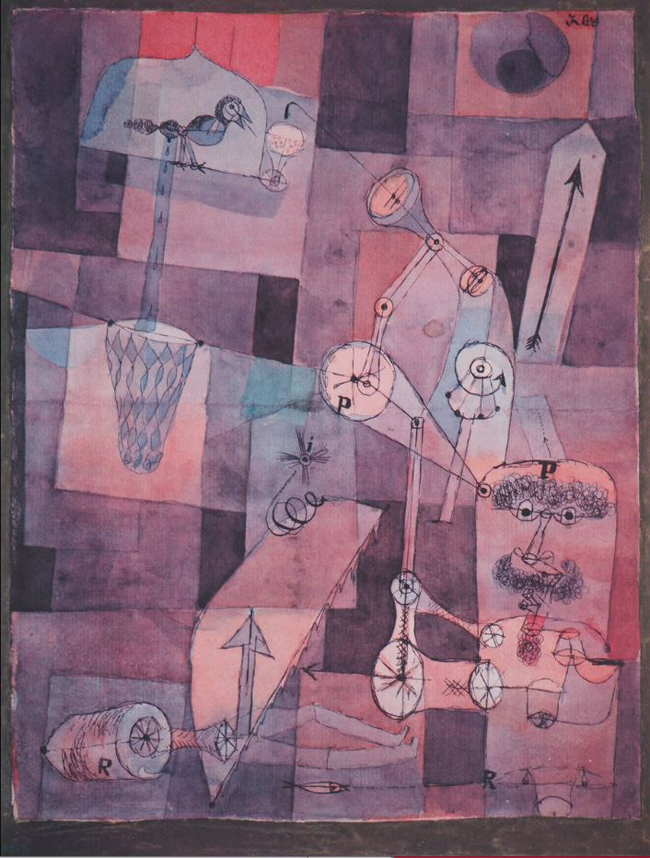Premature Withdrawal
by G. Murphy Donovan (June 2021)
Analysis of Perverse Diversities, Paul Klee, 1922
All progress depends on the unreasonable man. —GB Shaw
Even on a good day, Afghanistan lends itself best to suggestive, if not obscene, metaphors.
After, forty years America is about to submit, take another knee, before the Taliban. Similar to ISIS in the Levant, the Taliban is the dominant Sunni Islamist thug in South Asia. The 2021 exit from Kabul may make the 1975 skedaddle from Saigon look humane. After nearly a half century there are many scores to settle with apostates, infidels, and other American toadies.
Heads will literally roll.
Yes, it’s closer to 40 not “20 years” as you often read or hear from the Pentagon or American media. The Afghan War pre-dates 9/11 by a decade or more. The American adventure in South Asia, like Vietnam, ends as it began with lies; a reductio ad absurdum.
Tomfoolery in Kabul began shortly after 1979 as a CIA sponsored small war, nee “black” operation, against a Soviet installed secular client state in Kabul. The Russians withdrew in 1989, primarily to deal with the “revolution without guns” unfolding in Moscow. The old Soviet Union subsequently collapsed in the last decade of the 20th Century. If there was a “defeat” in 1989, it was in Europe not Afghanistan.
As the Warsaw Pact dissolved; CIA supplied guns, mines, missiles, and money to the Mujahideen in South Asia. A mujahid is literally a “fighter in the way of the lord,” an assortment of Islamic fighters we now know as the Northern Alliance, ISIS, Taliban, and/or al Qaeda. The shadow war against Russians and Communist clients was underwritten by a Texas cowboy, congressman Charles Wilson, and a rogue CIA agent, Gust Avrakotos.
The most publicized CIA ally, the so-called Northern Alliance, was led by Ahmad Shah Massoud, later to become Defense Minister. At best, Massoud never controlled more than the Panjshir Valley, 8 of 34 Afghan provinces. Massoud was just one of a dozen or more tribal chiefs most of whom were Islamists, then as now. Ahmad Shah was assassinated by the Taliban just two days before 9/11, after which the Northern “Alliance” vanished.
Massoud’s fame in life was a function of his status as a CIA favorite and media icon. He was a Tajik (Persian speaker) tribal leader who cultivated western press. The majority (42%) of Pakistanis are Pashtun. Pashto speakers, notably the Taliban, while less visible, had consistent support from Pakistan and Saudi Arabia, major financial and logistical players, to this day working both sides of the jihad street—whilst successive American administrations look the other way.
In 1996, the Taliban under Mohammed Omar, an illiterate Pashtun Mujahid, took Kabul after twenty years of civil war, in a toxic vacuum created, in part, by Charlie Wilson’s War. Wilson admitted as much in retirement. Clearly, while tribesmen might take American aid, they did not want Russian or American troops on Islamic soil.
Nevertheless, a subsequent second US invasion, now conventional, was advertised as a response to 9/11. The attack against New York and Washington, DC, as Wilson suggested, was stimulated, in part, by years of aimless American meddling.
Ahmad Massoud’s assassination in Kabul and the Saudi attack against New York and Washington two days later are jihad milestones separated only by geography.
Official America became so confused about sorting good Muslims from bad that the term Mujahideen disappeared from the counterinsurgency vocabulary altogether after 9/11. Someone at CIA probably finally realized that the root of the word Mujahid is literally “jihad.”
Most of the weapons supplied to tribal warlords by CIA originated in Europe, Russia, or Egypt and were shipped to Afghanistan via Pakistan. Few weapons, save stinger missiles, were tracked after they crossed the Afghan frontier in the 1980’s. Russian Kalashnikovs killing Russians in Afghanistan was a running joke at Langley. Americans support to Mujahideen was thought to be payback for Russian support for the North Vietnamese.
When the American mission in Kabul after 1989 went from anti-Soviet to anti-Afghan (nee counterinsurgency), that sea change was recognized by Muslim zealots in Anwar long before it dawned on home grown naïf’s at Langley. By year 2001, Afghanistan was a DOD problem. Withal, America was toying with Muslim religious hornets in Afghanistan long before and long after the Russians left – and long before and long after 9/11.
When Kabul was retaken by American proxies in 2001, that second so-called “victory” was again, a public relations win. The Taliban may have been expelled from Kabul and a few other towns, but they retreated to the provinces to play the long game. Today, fundamentalist Taliban mujahid control most of the country outside the wire. American green zones in the Ummah are now like US Calvary forts in Apache territory during the 19th Century.
If anyone is keeping score, the joint efforts of CIA and DOD have enabled, or created, no fewer than a half dozen Islamist theocracies, including Turkey, since 1950. Indeed, if Iran gets John Kerry’s latest benediction, the Islam bomb will have proliferated to the Shite side of the Muslim rift, giving the Sunni/Shite schism a bilateral radioactive punch.
The first casualty might be Israel.
Putative allies; Afghanistan, Pakistan, and Saudi Arabia still play host to Islamists responsible for 9/11 and other atrocities. The bin Laden kill, in 2011, took twice as long as WWII and still did not put al Qaeda, to say nothing about the Muslim Brotherhood, out of business. American Intelligence is fond of representing some restive tribes of Afghanistan as “freedom fighters.” Ironically, Jihadists in Afghanistan finance their terror and ideology with opium now. The best customers for such hard drugs are NATO member states, especially America. The American drug high, an epidemic enabled by fundamentalist opium, is a slice of global poetic justice, a toxic irony that buggers imagination.
Afghanistan, with American indulgence, now produces over 90% of the world’s opium and 100% of the associated corruption.
 The “Company” might make the world safe for junkies. But only DOD is a better friend to “opium (child) brides,” “Bacha bazi” (boy pedophilia parties), and drug traders in Afghanistan. The dark side of Afghanistan is rationalized by the Pentagon as “culture.”
The “Company” might make the world safe for junkies. But only DOD is a better friend to “opium (child) brides,” “Bacha bazi” (boy pedophilia parties), and drug traders in Afghanistan. The dark side of Afghanistan is rationalized by the Pentagon as “culture.”
The Soviet retreat from Kabul in 1989 was a true “withdrawal.” Massoud allowed the 40th Army to leave. The exit was not a “defeat” so much as realpolitik. For Russia, there were bigger fish to fry in Europe. No such clarity ever enlightened American policy in Afghanistan. Charlie Wilson’s War against the Soviets predated 9/11 by years and morphed into a Department of Defense quagmire that now stalks the 50-year mark.
Folding a bad hand requires rare strategic courage.
Like Iran, Iraq, Libya, Syria, Kosovo, Bosnia, and Ukraine; CIA left America a war in Afghanistan, a fight that the Pentagon could not or would not win. What started as an anti-Soviet operation, became a religious civil-war. Indeed, the Afghans, like the Vietnamese before them, evolved into American targets.
A Proxy war is like a medical crusade that kills one patient demographic in the name of saving others.
The albatross at the Defense Department today is leadership. The best trained and equipped armed forces are led by effete flag officers, a corps more like political commissars. The leadership vacuum is compounded by an Intelligence of forgone conclusions; especially on all matters Russian or Islamic, cooked books useless to policymakers.
Small wars across the globe are now a kind a bad habit, perennial tactical military exercises with no clear strategic objective, end dates – or prospects for victory. As America flails blindly in assorted tactical and operational schismatic Muslim quarrels, the Chinese are eating Uncle Sam’s strategic lunch.
Who ever thought America would be playing catch-up with the Chinese – and now the Russians?
Small wars may represent a tolerable level of national pain, but the only happy war is the one you win – quickly. Alas, happy endings are off the table these days, if we can milk another metaphor.
Victory is no longer discussed at war college seminars or on the E-Ring at the Pentagon. Success is called “nation building” or “counter-insurgency;” tactical babble where CIA passes the kinetic buck to a Pentagon that cannot think strategically. As long as too many cadavers don’t show up at Dover AFB, a passive American public is content with the occasional slow-motion anti-climax these days.
Alas, defeat in Kabul is not just another fiasco like Saigon. Afghanistan is much worse by decades, body bags, and billions. A more appropriate comparison might be Iraq, an intervention for dubious reasons where the mission changed midstream and then a second war was necessary to “secure” another sketchy Islamic dependent.
Bad policy, however, often makes for good fiction and myth making. Charlie Wilson’s War has now been romanticized to the point that many Americans believe there were two big wins for America in South Asia; first against the Russians and then against the Taliban.
A commander of Russia’s 40th Army came closer to the truth when he reminded an American reporter that Afghanistan was the “graveyard of empires.” Russia and America came to Kabul, ironically, for the same reasons; to support and control unpopular, corrupt clients and proxies.
Losing the Bubble
Peter Drucker, more a student of human nature than military strategy, wrote a prescient essay about the Wilson/ Avrakotos tag team. He called them “monomaniacs” with a mission. Drucker made a list of 11 reasons for their operational success against the USSR’s 40th Army—and needed only one explanation for strategic failure. Drucker believed that Afghanistan suffered from “benign neglect” after the Soviet withdrawal, making the subsequent Taliban counter-coup possible.
Drucker, a management specialist, suggested that CIA and DOD, instead of following up on tactical success in the 80’s returned to “business as usual.” Surely, apathy is the loudest voice in any bureaucracy. Withal, CIA and DOD, whose mandarins opposed Wilson/Avrakotos schemes for years, were quick to take a bow after the Soviet withdrawal; the station declaring “WE WON” in bold letters back to Langley. Besides hubris, the fatal flaw here is the persistent conflation of tactical with strategic; winning battles whilst losing wars.
The back slapping approached ludicrous when the fall of the USSR was linked to the Russian retreat in Afghanistan, again confusing tactical punctuation with strategic narrative. Like Vietnam; ethnic, tribal, and especially religious nationalism in Afghanistan was ignored in the name of Communist containment.
With no Russians or Communists to kill after 2000, the Afghan patient became the victim. The new threat on the front burner was “the war on terror,” a meaningless cliché that ignores the global politics of religious imperialism, religious fascism in some cases, and ignores Muslim state sponsors across the Ummah.
After the 9/11 jihadist attack against New York and Washington, prominent Saudi aliens were given an expedited VIP return trip to Riyadh before the blood was dry at the Twin Towers and the Pentagon.
Just before the turn of the Century Frank Fukuyama prophesied The End of History and the post-ideological world; in short, the global triumph of liberal democratic ideals. A cynic might argue, thirty years hence, that the Third International finally died in Moscow in 1990 only to come back like a vampire in Brussels and Washington in the 21st Century.
__________________________________
G. Murphy Donovan is a Vietnam veteran, a former USAF Intelligence officer who now writes about the politics of national security.
Follow NER on Twitter @NERIconoclast
